#site specific
Explore tagged Tumblr posts
Text

In ‘Fictional Nature,’ Fabian Knecht Encloses Live Trees and Craggy Stones in a White Cube Gallery
555 notes
·
View notes
Text
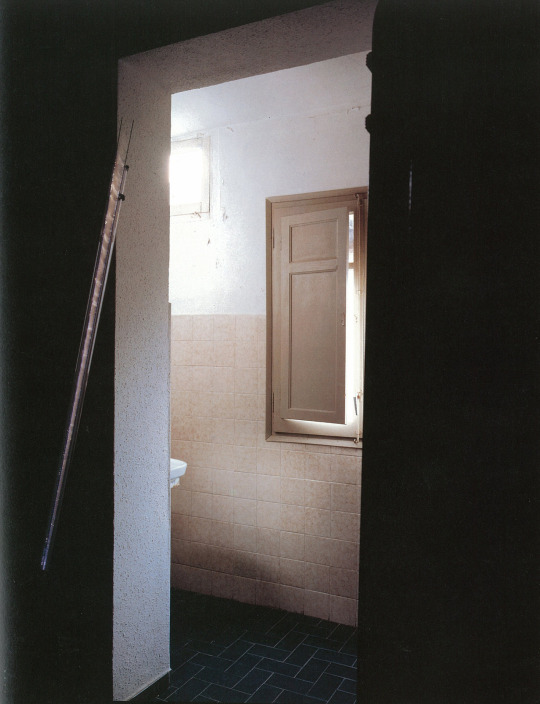
Rebecca Horn, Room of Fire, Radiance, installation, 1992
51 notes
·
View notes
Text







Reconfigured Cycle Rack [Wildlife habitat sculpture] Reclaimed Stainless Steel June 2022
Amy Haigh
The Reconfigured Cycle Rack is a sculptural habitat installed as a public art piece on the University of Surrey's Stag Hill campus. The piece makes use of reclaimed cycle racks from the uni grounds. The racks were cut down into around 600 pieces and reassembled to form a dome structure that houses a log pile in its centre.
My research focused mainly on slow worms and stag beetles as protected species present in the area. Decaying log piles are essential for stag beetles as a food source, with the material also attracting invertebrate species for slow worms to feed on. The metal pipes absorb heat and protect the log pile from the direct sun, in this way they form a haven for slow worms searching for a place to eat or bask.
The sculpture was commissioned for Surrey Hills Arts' HABITAT project. The project took a small area on campus at the University of Surrey, transforming it through planting and the introduction of four sculptural habitats to support local wildlife with support from Surrey Wildlife Trust.
This work, as part of the HABITAT project, was recently shortlisted for the Guildford Design Awards 2023.
See more of my work at amyhaigh.xyz
#ecology#habitat#outdoor sculpture#artwork#modern art#sculpture#public sculpture#sculptor#environment#animals#insects#bug hotel#bugs#nonhuman#zoology#ethology#garden#garden design#garden sculptures#metal#steel#metal sculpture#slow worm#stag beetle#site specific#public art#art#research#field research#surrey
7 notes
·
View notes
Text
SHY SOCIETY: Installazione Iperrealista a Palazzo Strozzi
Dallo scorso 24 ottobre è possibile vedere SHY SOCIETY, la nuova installazione site-specific nel cortile di Palazzo Strozzi. Realizzata dal duo artistico Drift, è un’opera “ipnotica” che attira lo spettatore ammirato ed incuriosito dalla complicità di arte, natura e tecnologia. comunicato stampa : Nell’ambito del programma Palazzo Strozzi Future Art, in collaborazione con la Fondazione Hillary…
0 notes
Text
PSA: Tumblr/Wordpress is preparing to start selling our user data to Midjourney and OpenAI.
you have to MANUALLY opt out of it as well.
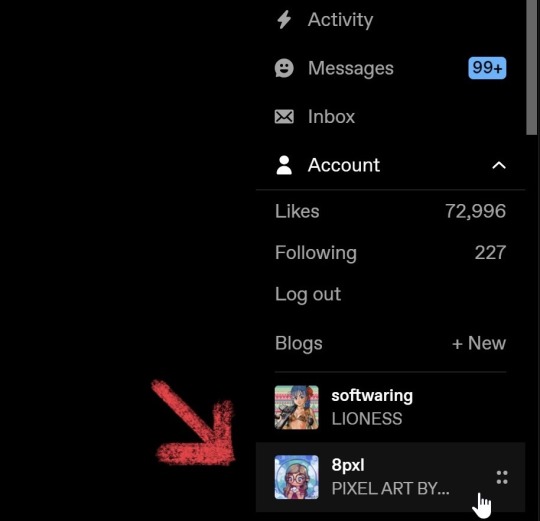
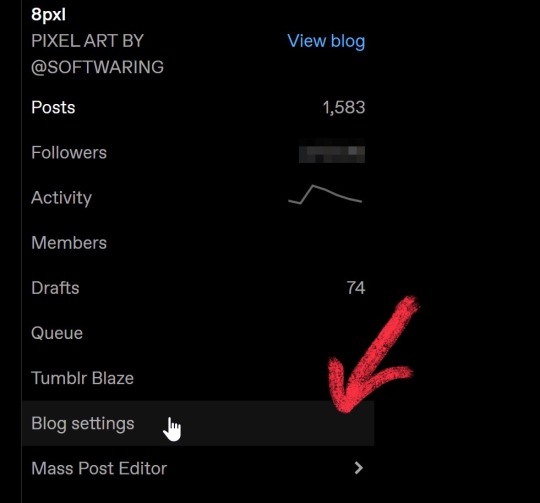
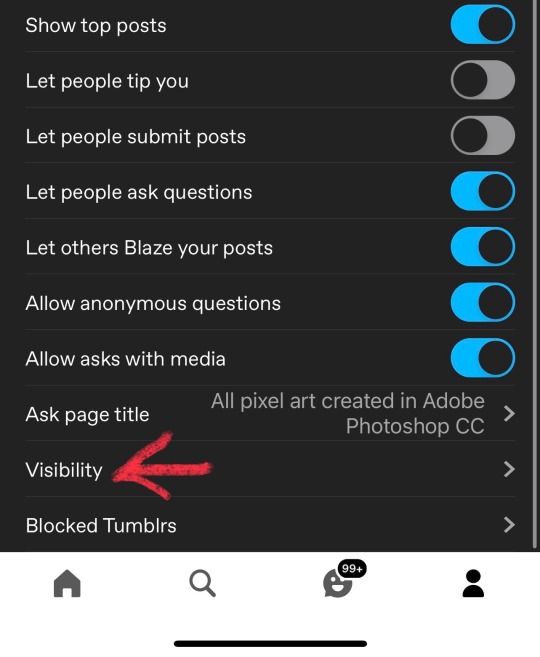

to opt out on desktop, click your blog ➡️ blog settings ➡️ scroll til you see visibility options and it’ll be the last option to toggle.
to opt out on mobile, click your blog ➡️ scroll then click visibility ➡️ toggle opt out option.
if you’ve already opted out of showing up in google searches, it’s preselected for you. if you don’t have the option available, update your app or close your browser/refresh a few times. important to note you also have to opt out for each blog you own separately, so if you’d like to prevent AI scraping your blog i’d really recommend taking the time to opt out. (source)
#ai#tumblr ai#midjourney#openai#protect your creative efforts and don’t let them profit off your work!!#fuck tumblr they specifically said months ago they’d NEVER sell user data yet here we are#AND after the ceo has been harassing trans users like wtf is this fucking site becoming#tumblr news#tumblr#tumblr update#anti ai#support human artists
34K notes
·
View notes
Video
DSC_3757 Assemblage by Russell Moreton Via Flickr: Ceramic Vessels on Site Specific Ground 2019 On the nature of creative inquiry Indexical markings into the aesthetic realm between objects
#indexical objects#painting#surface#texture#architectural#ceramic#Russell Moreton#aesthetics#materiality#praxis#ontology#art practice#Outpost#Norwich#Anglian Potters#Making#innerness#cell#court#domain#field#ground#site specific#performative#exhibition#flickr
1 note
·
View note
Text
something you really learn from this site is that 'sounding reasonable' is a writing style you can just adopt while saying bizarre things, and if you just sound sure enough you are in fact the most reasonable person online about 80% of all users will just assume you are in fact so very reasonable, that your sources check out and you are drawing reasonable conclusions from them. You don't actually need to make sense.
If you use the right tone you can also, essentially without effort, convince people anyone who disagrees has evil motivations or convictions in some way. Convincingly performed indignation makes people very apologetic/makes them side with you because this is a very scary emotion to them (the userbase is terrified of being guilty or siding with the guilty). Doesn't matter what you're actually saying this applies in basically any situation. But you cannot use dated memespeak or writing styles popular on this site 2+ years ago because those annoy everyone and make you look stupid and easy to make fun of.
again it doesn't matter what you're actually saying. This site is all about tone. It's basically like talking to a baby or perhaps a small dog. it's about sounding cool.
6K notes
·
View notes
Text
A Touch from the Abyss
“To forget would not only be dangerous but offensive; to forget the dead would be akin to killing them a second time.”— Elie Wiesel, preface to ‘Night’ (2006)
As if free-falling, the body plunged into darkness. Humid air dampened the skin, cooled the ground, and diffused an earthy scent. The wind’s symphonies sounded celestial from a distance, enchanting the listener into nocturnal woods. This ambience was characterised by “âm”, the form and expression of ‘And They Die a Natural Death’ (2022) by artist and filmmaker Nguyễn Trinh Thi. A homophone in the Vietnamese language, âm has different usages, some of which provide clues to understanding humanist concerns in this work.
In the Vietnamese language, the syllable âm denotes distinct meanings. As a Vietnamese observer, I realised an existing language barrier—artistically and linguistically—that poses a challenge in contextualising ‘And They Die a Natural Death’. By introducing the word âm, I attempt to illuminate foundational layers of Nguyễn Trinh Thi’s presence at documenta fifteen, which is arguably one of the most prominent global exhibitions.
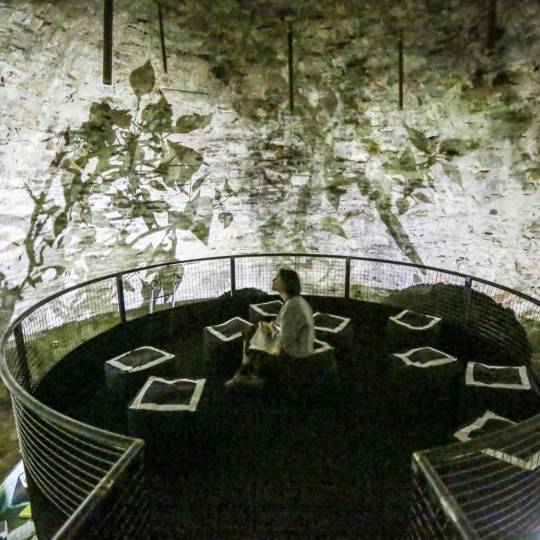
Nguyễn Trinh Thi, ‘And They Die a Natural Death’, 2022, chilli pepper plants, wind, bamboo flutes, projection, monitor. Installation view, Rondell, Kassel. Image courtesy of the artist.

Rondell (circular building on the left), exterior view, Kassel, 2006. Photo by Eva Kröcher. Wikimedia Commons.
Âm 音: sonic, sound
A site-specific art installation, ‘And They Die a Natural Death’ was a public intervention reviving Rondell—Kassel’s long-standing defensive tower built in 1523 and was said to later house torture facilities in its underground vaults. As part of the installation, a high-tech system recreated and implanted the natural environment of Tam Đảo forest in Vietnam. Via this hidden automated design, the Tam Đảo wind was generated in Rondell’s interior, and composed rhythms with the bamboo flutes in the dome. In this absolutely dark cinematic space, sound became the main device to storytelling.
Recently, Nguyễn Trinh Thi began to incorporate new media in her work, including organic materials and natural forces, prioritising the art of listening over mere representation. She experimented with sound as the primary technical apparatus. An ethnographic research trip to the Central Highlands of Vietnam in 2021 touched the artist so significantly that she dedicated her film to the J’rai culture of listening.2 ‘How to Improve the World’ (2021) is the documentary film that acts as a prelude to ‘And They Die a Natural Death’. By appropriating musician John Cage’s diary titled ‘How to Improve the World: You Will Only Make Matters Worse’ (1992), the filmmaker suggests that we should listen to the world around us to survive ecological crises together.3
Âm 荫: tree shade
The Tam Đảo wind not only created sounds inside Rondell, but also activated a lighting system to blow up silhouettes of bird’s eye chilli plants hidden underneath the platform. Enlarged shadows reached the highest parts of the dome, casting a luxuriant forest onto Rondell’s circular wall. Using small plants as main actors, the artist built an eco-theater in which non-human agency played a crucial role in the retelling of death. Chilli pepper shadows inside Rondell formed a panoramic ink painting, and this visual quality could be said to reference East Asian traditional art. In feudal China, the landscape genre seeks to express harmony between Heaven and Earth and cosmic wholeness between humans and nature, and this is observed with the installation.
Nguyễn Trinh Thi’s use of shadow as a visual signifier is not unlike American American artist Kara Walker’s signature strategy, which elicits the legacy of slavery through stereotypical--often grotesque--cut-paper silhouettes. Such technique aids the artists to walk the lines between pleasure and pain, visibility and invisibility, power and oppression.
Preparation of chilli pepper plants before being installed underneath the viewer's platform in the Rondell. Original caption: “She took care of everything - production, plants, people, and text. I’m deeply grateful.” Image courtesy of the artist.
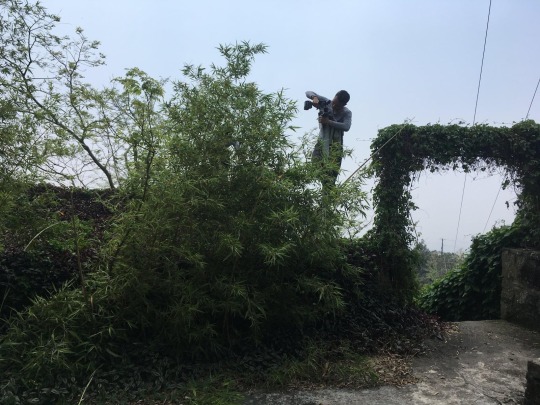
The electrical system which measured the wind’s intensity was being set up in Tam Đảo, Vietnam. Originally captioned “Thank you so much Đức for sending us your wind!!!” Image courtesy of the artist.
Âm 喑: muteness
Like the other projects at documenta fifteen, Nguyễn Trinh Thi’s installation recalled a testimony denied by grand history. ‘And They Die a Natural Death’ was a mute cry for loss and brutality. The artist referenced a chapter in Bùi Ngọc Tấn’s memoir in prison, A Tale For 2000.4 In the labour camp, male prisoners longed for the spicy heat of chilli pepper. One day, the discovery of a vast pepper tree forest caused an uprising in the camp. Unable to control the mob, furious guards fired in the air and ended up shooting a prisoner. The mob went silent and returned to the camp; their hands still held on to the chilli peppers as if it represented fleeting freedom.
As a site-specific project, ‘And They Die a Natural Death’ connected to local history in Kassel. In the Nazi era, the city witnessed book burning, destruction of Jewish synagogue, concentration camps, and Adolf Hitler’s speech in the first Reich Warriors’ Convention. Within this context, the installation can be interpreted as a passive mourning. Its dim lights and eerie sounds gestured towards, in the words of philosopher Jacques Ranciere, “the representation of the inhuman.”5 This rhetorical device employs micro-description of actions, which highlights the absence of humanity experienced in prisoner camps from Bùi Ngọc Tấn’s memoir and Kassel’s Nazi past.
Âm 陰: the underworld
Nguyễn Trinh Thi is neither the first nor the only artist to adapt a ruin’s history in a retelling of memory. However, her philosophy, deeply rooted in Taoism, fostered aesthetic qualities that were peculiar to East Asian and Vietnamese worldviews. In 1987, German artist Rebecca Horn also addressed history by staging a site-specific installation ‘Concert in Reverse’ in a Munster fortification, which was built around the same time as Rondell. While both artists intrigued their audiences with cinematic experiences and sounds from ordinary tools, for Nguyễn Trinh Thi, darkness was crucial to the mise-en-scène of death. Such an artistic strategy inserted the Vietnamese spiritual belief that the dead are not far gone, and that their souls stay in the underworld. With its 10-metre-thick wall, humid air, and absolute absence of light, Rondell became a vessel, displacing viewers to enter a space outside of time. The haunting yet meditative ambience enchanted listeners to feel a tender touch from the abyss.
A story about death is a reminder that nature’s flow waits for no one. However, by narrating death, both storyteller and listener resist this flow and encounter the deceased in a parallel reality. This temporal convergence offers a space for grief, and in some cases, the telling of death helps to make sense of loss.
At documenta fifteen, Nguyễn Trinh Thi presented her ongoing investigation of anti-representation, nonhuman agency, and power. She conceived of “landscapes as quiet witnesses to history.”7 ‘And They Die a Natural Death’ was a live theatre in which nonhuman actors--wind and chilli pepper plants--took centre stage. In this nonverbal retelling of death, artistic strategies were utilised to engage the viewer’s multiple senses. By imagining a gate to the underworld, the artist staged a landscape that connected Kassel and the Tam Đảo forest where the prisoner died a natural death.
1 note
·
View note
Text
Food Research III
Agnes Denes, Wheatfields.
https://www.jstor.org/stable/1576033?searchText=agnes+denes&searchUri=%2Faction%2FdoBasicSearch%3FQuery%3Dagnes%2Bdenes&ab_segments=0%2Fbasic_search_gsv2%2Fcontrol&refreqid=fastly-default%3A6d6e0d801860ce21c84a919bb8c30c3d&seq=3
WHEATFIELD - A CONFRONTATION
“My decision to plant a wheatfield in Manhattan instead of designing just another public sculpture grew out of the long-standing concern and need to call attention to our misplaced priorities and deteriorating human values. Manhattan is the richest, most professional, most congested and, without a doubt, most fascinating island in the world. To attempt to plant, sustain and harvest 2 acres of wheat here, wasting valuable real estate and obstructing the "machinery" by going against the system, was an effrontery that made it the powerful paradox I had sought for the calling to account. It was insane. It was impossible. But it would call people's attention to having to rethink their priorities and realize that unless human values were reassessed, the quality of life, even life itself, was in danger.”
“Placing it at the foot of the World Trade Center, a block from Wall Street, facing the Statue of Liberty, also had symbolic import. My work usually reaches beyond the boundaries of art to deal with controversial global issues. Wheatfield was a symbol, a universal concept. It represented food, energy, commerce, world trade, economics. It referred to mismanagement, waste, world hunger and ecological concerns. It was an intrusion into the Citadel, a confrontation of High Civilization. Then again, it was also Shangri-la, a small paradise, one's childhood, a hot summer afternoon in the country, peace, forgotten values, simple pleasures.”
Using the idea of wastage and blocking of resources to call attention to potential issues down the line – makes sense although a bit paradoxical, seems to have been intentional, or at least reasoned as such.
The contrast between the wheat field - growing on a landfill site - and the surrounding Wall Street area of Manhattan, with a view of the Statue of Liberty - a lot going on.
Apparently some people cried at the harvest. The golden wheat had been a part of their landscape, and had to be reaped in the autumn. This in itself might make an office worker consider their physical place more actively, when going about their day-to-day drivels in the concrete jungle of one of the world's largest cities. The wheat has deep metaphorical and historical connotations.
Wheat was one of the first crops to be commodified, and in small societies before globalisation was the signifier of power - whoever controlled the wheat (therefore major source of food, bread) had power. Wheat growing freely by Wall Street (where the market for milling wheat exists as a benchmark for world prices - inflation, deflation, depression, etc.) directly goes against its monetary limitation and quantisation within the exchange forum. Here's some abstract concept you all buy and sell, you are not moving around 50 tons of milling wheat at a time. It is numbers, computers and theoretical stocks. Here is my field of wheat. Actual wheat that I can harvest and eat after tending to it. I find it very powerful because of its humanity. Denes does not throw numbers at us and chastise our lack of action. She puts the world as it used to be, and potentially should be, into the world as it is, and allows us to decide what we want, and study where we might have gone wrong with regards the environment and human interference.
0 notes
Text

green ants
1 note
·
View note
Text

Otherworldly Zip-Tie Sculptures by Sui Park Crawl Across Galleries and Sprout in City Parks
281 notes
·
View notes
Text

Fate Is Not Your Own
An embodiment of the feeling one might have whilst waiting on a decision that one has no direct control over. Often times, we are faced with big life changing moments which are 'out of our hands’. Which places us in a state of limbo, as our next steps solely depends on the outcome after the awaited decision. The immensity of these moments and emotions which we often repress in areas of the public, especially in areas such as waiting rooms (as an example in hospitals or places of bureaucracy), is where this project draws inspiration from developing it into a movement piece. Representing a space of in-between, moments of optimisim and moments of doubt. Choreographed and performed site specific in one of the waiting rooms of Rathaus der Landeshauptstadt in Potsdam.
Performed 6 times in 2 days as part of 'Von Amts Wegen’ Localize Festival in October 2023
1 note
·
View note
Text
On the 12th of August, 2023, I went to see Sarah Sze’s site-specific interventions at the Solomon R. Guggenheim Museum. Her exhibition was titled: Timelapse, Curated by Kyung An
- B. Boston 1969
- Uses various mediums including painting, sculpture, print, drawing video and architecture
- Interventions go up from the elevator to the top floor where her work ‘Time Keeper’ 2016 is kept at Tower Level 7 (multi sensory installation)
#sarah sze#guggenheim#timelapse#installation#installation art#fine art#sculpture#contemporarypainting#contemporary art#site specific
0 notes
Photo

Large modern white two-story wood flat roof idea
0 notes
Text
SHY SOCIETY: Installazione Iperrealista a Palazzo Strozzi
Dallo scorso 24 ottobre è possibile vedere SHY SOCIETY, la nuova installazione site-specific nel cortile di Palazzo Strozzi. Realizzata dal duo artistico Drift, è un’opera “ipnotica” che attira lo spettatore ammirato ed incuriosito dalla complicità di arte, natura e tecnologia. comunicato stampa : Nell’ambito del programma Palazzo Strozzi Future Art, in collaborazione con la Fondazione Hillary…
0 notes
Text
Formal - Modern Living Room

Example of a large, formal, minimalist living room with a limestone floor, white walls, a two-sided fireplace, and a stone fireplace.
0 notes